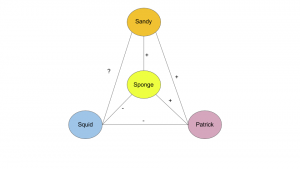Structural Balance Applications Within Spongebob’s Network
A popular children’s T.V. show, Spongebob Squarepants provides an interesting case with respect to structural balance concepts. Within the show, we can find robust, amiable relationships along with unfriendly relationships. Casual viewers, or those simply remembering past episodes, may be able to name many relationships. I find that it is Sandy’s relationship with Squidward that has the least concrete status and therefore interesting interpretations.
For those unfamiliar, Spongebob is the main character in the show bearing his name. He is a sea sponge that lives in a pineapple with his pet snail. Spongebob is, for the most part, confined to the city that he lives in: Bikini Bottom. His immediate environment could be considered his street where he has Squidward Tentacles and Patrick Star for neighbors. These two individuals make up part of Spongebob’s network. Patrick, a starfish that lives under a rock (literally and arguably figuratively), is Spongebob’s best friend and virtually all episodes feature them. Interestingly, Spongebob is not immediate neighbors with Patrick. Their properties are physically separated by the property of Squidward. In his Moai house, Squidward is arguably an enemy of Spongebob and Patrick. He sees them both as dimwits and is ultimately annoyed by their existence. Through this relationship, there is balance.
It is the inclusion of Sandy Cheeks, a friend of both Spongebob and Patrick, that clouds the balance. In addition to being friends with the two formerly mentioned, she is certainly aware of Squidward. According to the community supported wiki on the topic (http://spongebob.wikia.com/wiki/Squidward-Sandy_Relationship), the relationship between Sandy and Squidward is not entirely unfriendly. We have:
So far, we have constructed a balanced triangle with three + indicators between Spongebob, Patrick, and Sandy. We also have a balanced triangle between Spongebob, Patrick, and Squidward that features two – indicators and a single + indicator. Theory would tell us that the edge between Squidward and Sandy must be negative in order to generate structural balance. The theory states that given a – and + pair of edges, the most socially and psychologically plausible result for the third edge is a – (Easley & Kleinberg, 2017). We should expect Sandy and Squidward to be enemies. As mentioned, this is not necessarily the case. Our wiki states that episodes like “Squidtastic Voyage”, “Squid Defense”, and “Best Day Ever” support a friendship claim. This would produce an unbalanced triangle featuring edges of -, +, and +. To add another detail, while friendly, Sandy and Squidward do not speak with each other very often. In general, a lack of communication may signal a negative relationship. It is in this way, using the structural balance property, that we can explain Sandy’s friendly, but otherwise distant relationship with Squidward.

